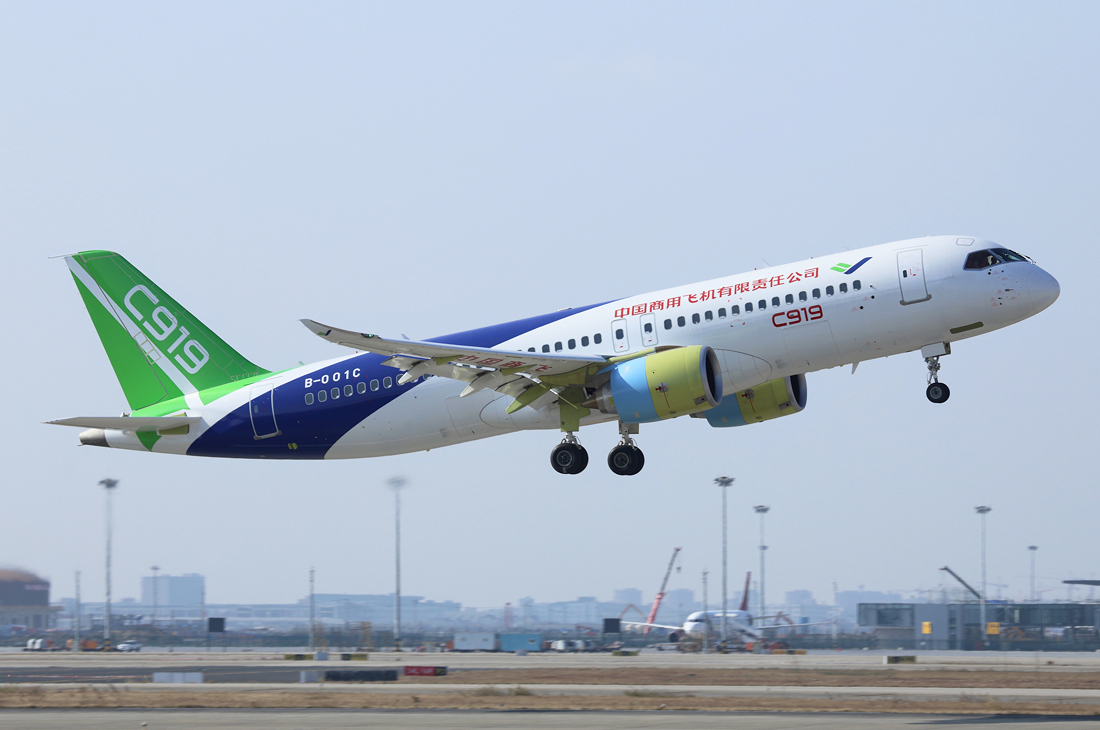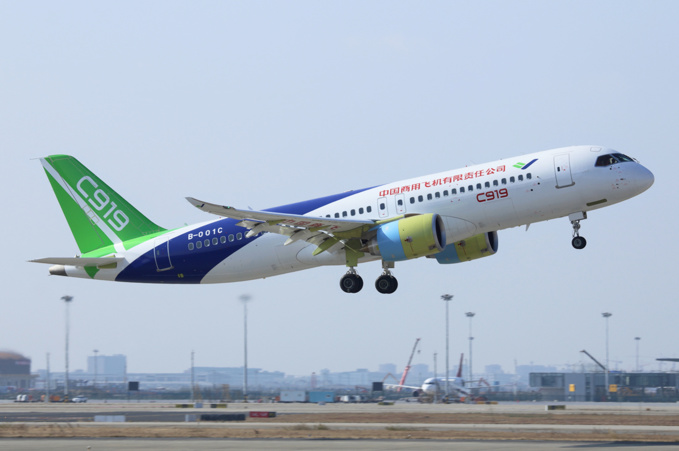The Chinese mainline narrow-body aircraft C919 has not yet passed certification tests, but is already becoming one of the most popular airliners in its segment.
In February, the Chinese Commercial Aircraft Corporation (COMAC), which produces C919, announced that it had already received over 800 orders for a new aircraft from 28 domestic and foreign buyers.
By signing an agreement with the Chinese financial company Huazhun for 30 aircraft, COMAC brought its portfolio of orders for C919 to 815 units.
The C919 is the first serious attempt by Chinese aircraft designers to gain a foothold in the niche of single-aisle aircraft and press Duopoly Airbus and Boeing in this market. The country's leadership hopes that this airliner will help get rid of dependence on foreign suppliers of aircraft.
In the long run and in the case of successful operation, C919 may become a cheaper replacement for the Airbus 320 and Boeing 737, which hold the selling price at $ 70-120 million compared to $ 50 million for the Chinese airliner.
Since 2008, COMAC has been developing and producing C919. The first sample of the new liner was assembled at a plant in Shanghai in November 2015. The vessel made the first test flight at Shanghai Pudong International Airport on May 5, 2017.
The Chinese manufacturer has repeatedly stressed that it intends to create the most reliable, safe and cheap aircraft.
Perhaps one of the secrets of success is that the C919 project is not of a Chinese design itself. Several western companies took part in development of the vessel. Thus, avionics, including communication, navigation and control systems, is partly supplied by Rockwell Collins from the USA and its Chinese partners. LEAP-1C engine is manufactured by CFM International, a joint venture of American General Electric and French Safran. Similar installations are also used on some Airbus and Boeing aircraft. The computer system, cockpit displays and black boxes are supplied by GE Aviation and AVIC Systems, power supply systems are made by Hamilton Sundstrand and AVIC Systems.
Despite the smaller flight range of 1.5 thousand km compared to Airbus320 and Boeing 737, the advantage of the C919 is the maximum cruising speed of 901 km/h, as well as lower fuel consumption compared to competitors.
At the moment, there are three copies of C919: the plane has passed the whole cycle of ground tests, and also made flights from Beijing to the Heihe city (Heilongjiang province), Hailar in Inner Mongolia and Sanya on Hainan Island.
At the same time, Xinhua News Agency recently quoted the press service of COMAC as saying that it is planned to speed up the flight tests of the C919 aircraft. So, this year the number of aircraft involved in test flights will reach six. COMAC is also considering launching their mass production. The test flights in difficult weather conditions will take place at several bases in the country.
The aircraft is expected to be certified in the next year, and the first commercial deliveries of the C919 are scheduled for 2021.
Given that the preliminary work on the C919 began in 2010, the aircraft itself was first presented to the public in 2015, and the first flight tests began in 2017, China may well cope with the launch of the aircraft until 2021.
source: xinhuanet.com
In February, the Chinese Commercial Aircraft Corporation (COMAC), which produces C919, announced that it had already received over 800 orders for a new aircraft from 28 domestic and foreign buyers.
By signing an agreement with the Chinese financial company Huazhun for 30 aircraft, COMAC brought its portfolio of orders for C919 to 815 units.
The C919 is the first serious attempt by Chinese aircraft designers to gain a foothold in the niche of single-aisle aircraft and press Duopoly Airbus and Boeing in this market. The country's leadership hopes that this airliner will help get rid of dependence on foreign suppliers of aircraft.
In the long run and in the case of successful operation, C919 may become a cheaper replacement for the Airbus 320 and Boeing 737, which hold the selling price at $ 70-120 million compared to $ 50 million for the Chinese airliner.
Since 2008, COMAC has been developing and producing C919. The first sample of the new liner was assembled at a plant in Shanghai in November 2015. The vessel made the first test flight at Shanghai Pudong International Airport on May 5, 2017.
The Chinese manufacturer has repeatedly stressed that it intends to create the most reliable, safe and cheap aircraft.
Perhaps one of the secrets of success is that the C919 project is not of a Chinese design itself. Several western companies took part in development of the vessel. Thus, avionics, including communication, navigation and control systems, is partly supplied by Rockwell Collins from the USA and its Chinese partners. LEAP-1C engine is manufactured by CFM International, a joint venture of American General Electric and French Safran. Similar installations are also used on some Airbus and Boeing aircraft. The computer system, cockpit displays and black boxes are supplied by GE Aviation and AVIC Systems, power supply systems are made by Hamilton Sundstrand and AVIC Systems.
Despite the smaller flight range of 1.5 thousand km compared to Airbus320 and Boeing 737, the advantage of the C919 is the maximum cruising speed of 901 km/h, as well as lower fuel consumption compared to competitors.
At the moment, there are three copies of C919: the plane has passed the whole cycle of ground tests, and also made flights from Beijing to the Heihe city (Heilongjiang province), Hailar in Inner Mongolia and Sanya on Hainan Island.
At the same time, Xinhua News Agency recently quoted the press service of COMAC as saying that it is planned to speed up the flight tests of the C919 aircraft. So, this year the number of aircraft involved in test flights will reach six. COMAC is also considering launching their mass production. The test flights in difficult weather conditions will take place at several bases in the country.
The aircraft is expected to be certified in the next year, and the first commercial deliveries of the C919 are scheduled for 2021.
Given that the preliminary work on the C919 began in 2010, the aircraft itself was first presented to the public in 2015, and the first flight tests began in 2017, China may well cope with the launch of the aircraft until 2021.
source: xinhuanet.com



















